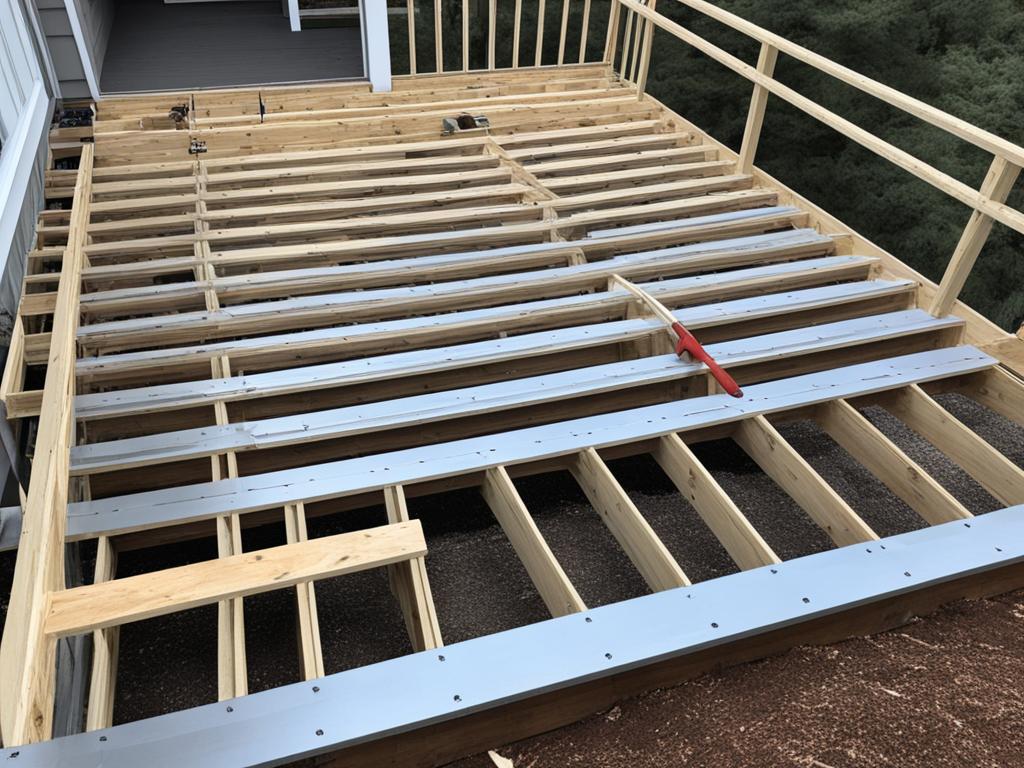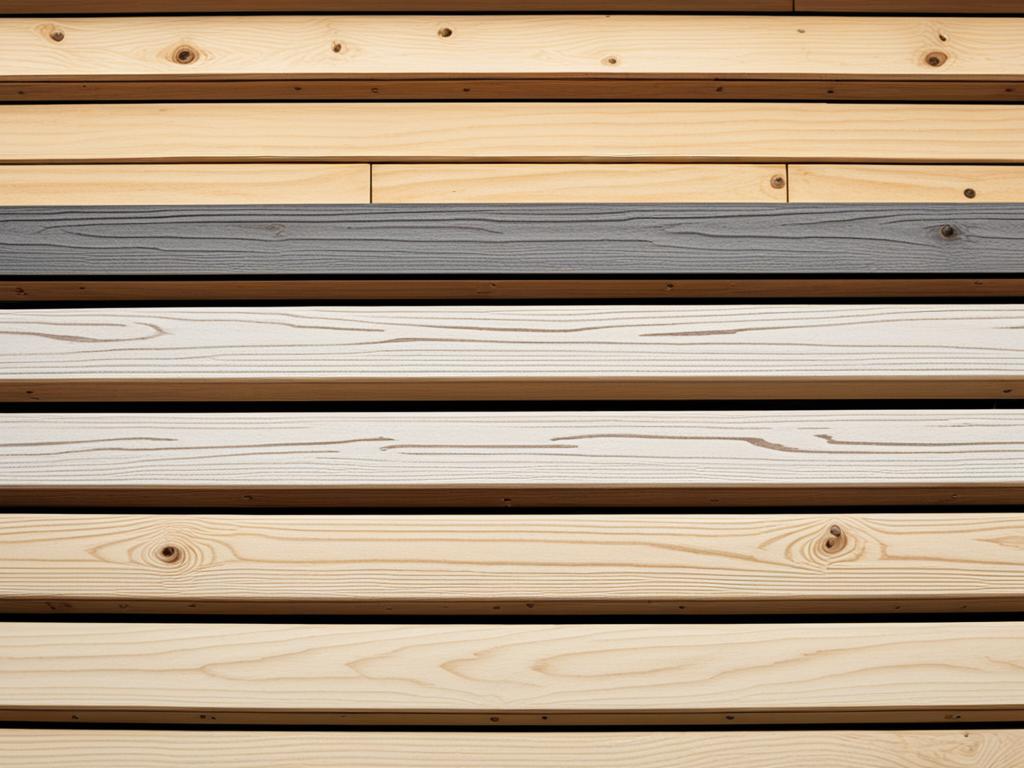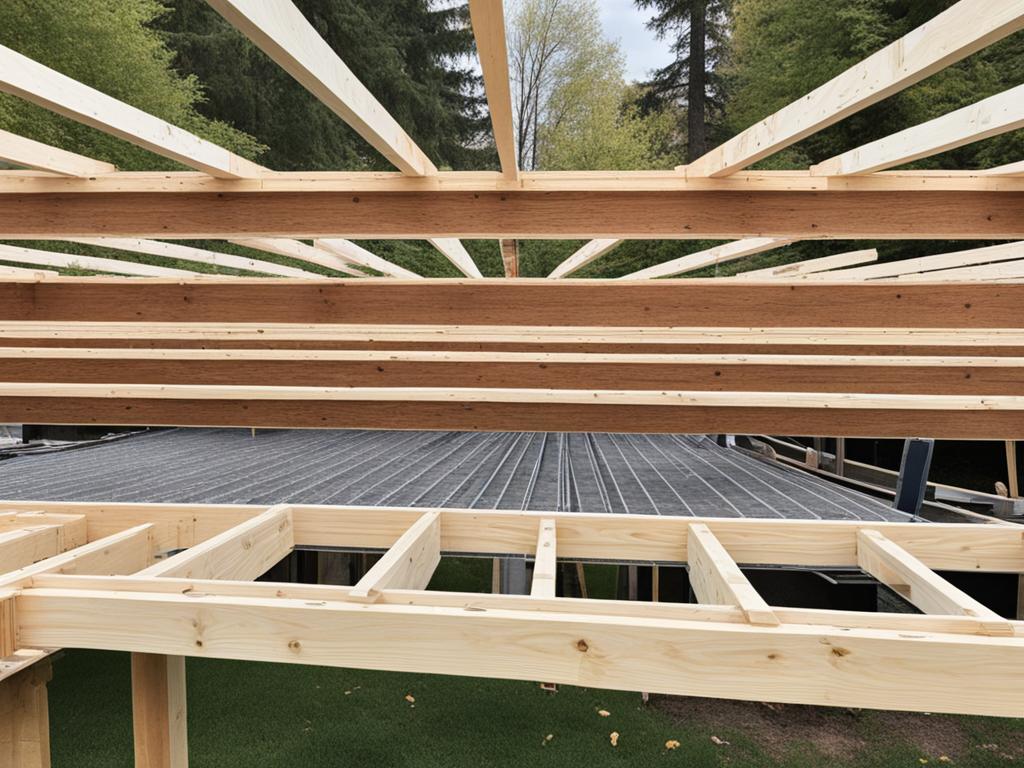Deck joist spacing is an integral part of deck planning and construction. Before purchasing materials or starting the build, it’s necessary to plan the size and shape of the deck, including the deck joist spacing and the joist span. The span and spacing of the deck joists can vary depending on the type of material used in the construction of the deck.
Key Takeaways:
- Deck joist spacing is an important consideration for a deck’s stability and durability.
- The joist span and spacing depend on factors such as deck size, shape, material, and load.
- Pressure treated lumber and steel joists are common options for deck construction.
- Calculators and tables can help determine the right deck joist size, spacing, and span.
- Consider factors like board layout and load capacity when choosing the right joist size for your deck.
Factors to Consider for Deck Joist Spacing
When planning the construction of a new deck, it’s essential to consider several factors for deck joist spacing. By carefully assessing these factors, you can ensure the structural integrity and longevity of your deck. Here are some key considerations:
- Deck Board Size, Shape, and Layout: The size, shape, and layout of the deck boards will determine the joist span and spacing. Different board sizes and patterns may require specific joist spacing to provide adequate support.
- Deck Elevation: The location of the deck, whether it’s close to the ground or elevated, will impact joist spacing. Decks closer to the ground may require closer joist spacing to prevent sagging and ensure stability.
- Choice of Deck Joist Material: The deck joist material is another critical factor to consider. Options include steel, composite, and lumber joists. Each material has different load-bearing capacities and recommended spacing requirements. It’s important to research and choose the appropriate joist material for your specific deck construction needs.
- Joist Size: The size of the joist will also impact the joist span and spacing. Wider joists generally provide more support and can accommodate greater weight loads. Comparing lumber sizes for decks, such as 2×8 and 2×10, can help determine the most suitable joist size for your project.
- Deck Load: Consider the intended use of the deck and the expected load it will bear. Foot traffic, furniture, and equipment can add significant weight to the deck. Heavier loads may require closer spacing to ensure the deck remains stable and safe.
If you plan on laying the deck boards diagonally or using a custom pattern, it’s recommended to use 12-inch on center joist spacing. This additional support helps to distribute the load evenly across the joists.
To assist in determining the ideal joist spacing for your deck, consult local building codes and regulations, as well as reference deck construction guides and resources. These resources can provide specific guidelines based on your geographic location and deck design.
Deck Joist Spacing Considerations Quote:
“Proper deck joist spacing is crucial for ensuring the structural stability and safety of your deck. By taking into account factors such as deck board size, elevation, joist material, size, and load, you can determine the optimal spacing for your specific deck construction needs.”
Remember, deck joist spacing is not a one-size-fits-all approach. It’s important to consider all these factors and use them collectively to determine the ideal joist spacing for your deck. Taking the time to plan and calculate the proper spacing will ensure a sturdy and durable deck that can withstand the test of time.
| Factors | Considerations |
|---|---|
| Deck Board Size, Shape, and Layout | Different board sizes and patterns may require specific joist spacing to provide adequate support. |
| Deck Elevation | Decks closer to the ground may require closer joist spacing to prevent sagging and ensure stability. |
| Choice of Deck Joist Material | Each material has different load-bearing capacities and recommended spacing requirements. |
| Joist Size | Wider joists generally provide more support and can accommodate greater weight loads. |
| Deck Load | Consider the intended use of the deck and the expected load it will bear. |

Deck Joist Spacing Considerations in Action:
Let’s take a look at a practical example to illustrate how these factors come into play:
John is planning to build a deck using 2×8 lumber and wants to ensure the deck joist spacing is appropriate for his design. He has decided to use composite deck boards, which have specific spacing requirements. John’s deck will be elevated and is intended for hosting gatherings and supporting outdoor furniture. Based on these considerations, John must take into account the recommended spacing for composite joists, the weight of the furniture and the anticipated number of guests. By carefully evaluating all these factors, John can determine the ideal joist spacing for his deck, ensuring its strength, stability, and longevity.
Choosing the Right Joist Size for Your Deck
The size of the joist plays a crucial role in determining the span and spacing of your deck. It directly affects the weight capacity and overall structural integrity. To determine the suitable joist width, you need to divide the total span of the joist by two and add two to the result. For example, a 12-foot span would require 2×8 joists as they provide adequate support.
However, it’s important to note that the joist size may vary depending on the type of decking material used and the desired load capacity of the deck. Different decking materials have different weight characteristics and structural requirements, which should be taken into consideration when selecting the right joist size for your project.
When in doubt, it’s always a good idea to consult a professional or utilize online deck joist span calculators to ensure you choose the appropriate joist size. These calculators take into account various factors such as the type of wood, spacing, deck board layout, and desired load capacity, providing you with accurate recommendations.
Remember, selecting the right joist size is essential for the stability and longevity of your deck. Investing time and effort into proper planning and consultation will ensure a solid foundation for your outdoor living space.

Deck Joist Size Considerations:
- The wider the joist, the more weight it can hold
- Determine the span and spacing based on the total deck size
- Consider the decking material and its weight characteristics
- Consult online calculators or professionals for accurate recommendations
Conclusion
Choosing the right deck joists is a critical decision in the planning and construction of your deck. Factors such as deck joist spacing, material, size, and span all contribute to the strength, design, and longevity of your deck. To ensure a safe and sturdy deck, it’s important to follow proper installation guidelines, consult building codes, and utilize resources like deck framing guides and joist spacing calculators.
Whether you opt for 2×8 or 2×10 deck joists, the key is proper planning and construction techniques. By considering factors such as deck joist installation, deck framing guide, and deck joist spacing guide, you can create a deck that not only meets your specific needs but also stands the test of time.
Remember, a well-designed and well-constructed deck is a valuable addition to your outdoor space. So take the time to carefully plan your deck, choose the appropriate deck joists, and ensure a seamless deck construction process. With the right preparation and attention to detail, your deck will provide you with years of enjoyment and relaxation.
FAQ
What factors should I consider when choosing between 2×8 and 2×10 deck joists?
What should I consider when planning the spacing of my deck joists?
How do I choose the right joist size for my deck?
What resources can I use to help with deck joist installation?
Source Links
- https://www.thespruce.com/deck-joist-spacing-7481356
- https://www.decksdirect.com/knowledge-builders/deck-joist-spacing
- https://www.newtechwood.com/blog/how-to-lay-decking-joists/
